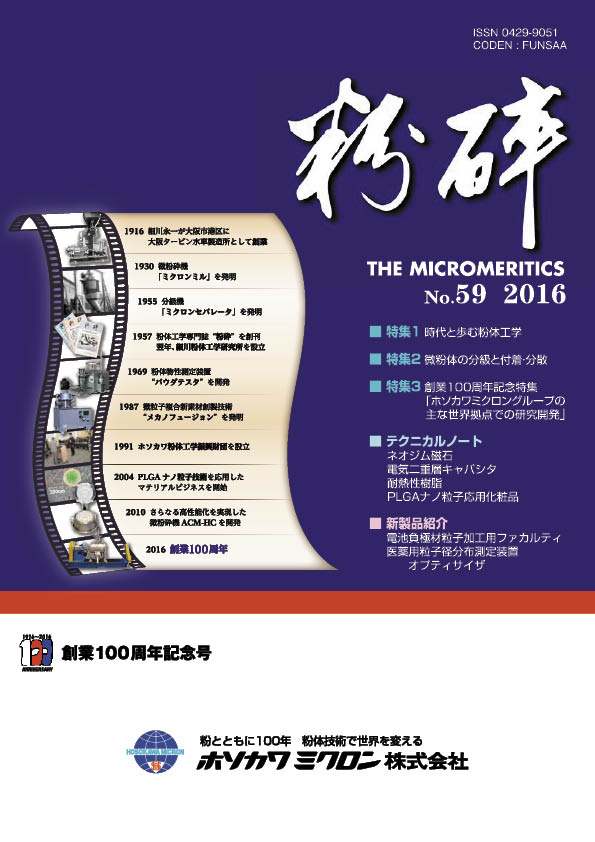Volume 59
Displaying 1-28 of 28 articles from this issue
- |<
- <
- 1
- >
- >|
Front Cover
-
2016Volume 59 Article ID: 2016001
Published: December 15, 2015
Released on J-STAGE: October 03, 2018
Download PDF (703K)
Editorial Board
-
2016Volume 59 Article ID: 2016002
Published: December 15, 2015
Released on J-STAGE: October 03, 2018
Download PDF (1139K)
Foreword
-
2016Volume 59 Pages 1-2
Published: December 15, 2015
Released on J-STAGE: October 03, 2018
Download PDF (1770K)
Special Subject I: Powder Technology, Advancing in Response to the Requirements of the Times
-
2016Volume 59 Pages 3-9
Published: December 15, 2015
Released on J-STAGE: October 03, 2018
Download PDF (1569K) -
2016Volume 59 Pages 10-16
Published: December 15, 2015
Released on J-STAGE: October 03, 2018
Download PDF (10591K) -
2016Volume 59 Pages 17-24
Published: December 15, 2015
Released on J-STAGE: October 03, 2018
Download PDF (7330K) -
2016Volume 59 Pages 25-32
Published: December 15, 2015
Released on J-STAGE: October 03, 2018
Download PDF (2016K) -
2016Volume 59 Pages 33-38
Published: December 15, 2015
Released on J-STAGE: October 03, 2018
Download PDF (10286K)
Special Subject II: Classification and Adhesion/Dispersion of Fine Particles
-
2016Volume 59 Pages 39-50
Published: December 15, 2015
Released on J-STAGE: October 03, 2018
Download PDF (2073K) -
2016Volume 59 Pages 51-59
Published: December 15, 2015
Released on J-STAGE: October 03, 2018
Download PDF (4843K)
Special Subject III: For the 100 anniversary of Hosokawa Micron Corporation
-
2016Volume 59 Pages 60-68
Published: December 15, 2015
Released on J-STAGE: October 03, 2018
Download PDF (7374K) -
2016Volume 59 Pages 69-78
Published: December 15, 2015
Released on J-STAGE: October 03, 2018
Download PDF (8637K) -
2016Volume 59 Pages 79-85
Published: December 15, 2015
Released on J-STAGE: October 03, 2018
Download PDF (2684K) -
2016Volume 59 Pages 86-90
Published: December 15, 2015
Released on J-STAGE: October 03, 2018
Download PDF (4152K)
Technical Note
-
2016Volume 59 Pages 91-95
Published: December 15, 2015
Released on J-STAGE: October 03, 2018
Download PDF (2758K) -
2016Volume 59 Pages 96-104
Published: December 15, 2015
Released on J-STAGE: October 03, 2018
Download PDF (1923K) -
2016Volume 59 Pages 105-107
Published: December 15, 2015
Released on J-STAGE: October 03, 2018
Download PDF (1825K) -
2016Volume 59 Pages 108-110
Published: December 15, 2015
Released on J-STAGE: October 03, 2018
Download PDF (9301K) -
2016Volume 59 Pages 111-116
Published: December 15, 2015
Released on J-STAGE: October 03, 2018
Download PDF (10027K)
New Products
-
2016Volume 59 Pages 117-119
Published: December 15, 2015
Released on J-STAGE: October 03, 2018
Download PDF (4907K) -
2016Volume 59 Pages 120-121
Published: December 15, 2015
Released on J-STAGE: October 03, 2018
Download PDF (1120K)
Business Overview
-
2016Volume 59 Pages 122-123
Published: December 15, 2015
Released on J-STAGE: October 03, 2018
Download PDF (1443K) -
2016Volume 59 Pages 124-125
Published: December 15, 2015
Released on J-STAGE: October 03, 2018
Download PDF (1676K) -
2016Volume 59 Pages 126-127
Published: December 15, 2015
Released on J-STAGE: October 03, 2018
Download PDF (3029K) -
2016Volume 59 Pages 128-130
Published: December 15, 2015
Released on J-STAGE: October 03, 2018
Download PDF (1071K) -
2016Volume 59 Pages 131-132
Published: December 15, 2015
Released on J-STAGE: October 03, 2018
Download PDF (8512K)
Topics
-
2016Volume 59 Pages 133
Published: December 15, 2015
Released on J-STAGE: October 03, 2018
Download PDF (593K) -
2016Volume 59 Pages 134-136
Published: December 15, 2015
Released on J-STAGE: October 03, 2018
Download PDF (940K)
- |<
- <
- 1
- >
- >|
